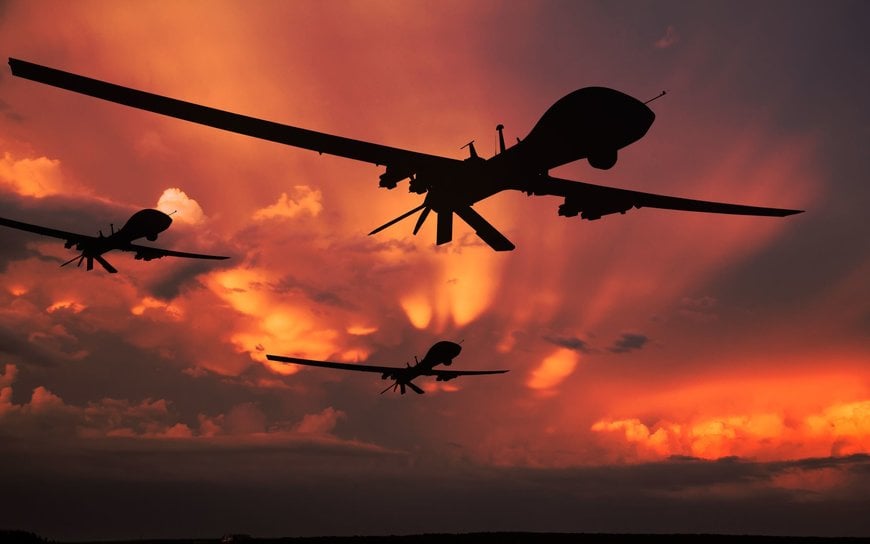www.magazine-industry-usa.com
16
'20
Written on Modified on
The role of AI in drone systems
Long gone are the days when armies would line up their soldiers in trenches as happened during World War I. Modern warfare is fought in the air, under the water and using advanced technologies that limit the need for “boots on the ground”.

Artificial intelligence (AI) is becoming crucial in military technologies and it has in recent years revolutionised the use of drones. In this article, Martin Frederiksen, managing director at military embedded systems specialist Recab UK, explains the usefulness of AI in military drone systems.
The latest operational intelligence is essential for the success and safety of modern defence missions. According to a report by MarketsandMarkets, AI in military is projected to grow from USD 5.42 billion in 2016 to USD 8.70 billion by 2022, at a compound annual growth rate (CAGR) of 14.75 per cent.
Unsurprisingly then, governments are speeding their investment in AI for the defence sector. One example is the US Department of Defence, which is financing a robotic submarine system that will aid in the detection of underwater mines. However, on land and in air, drones can prove highly useful for detecting and recognising targets, making military operations more accurate.
Compared with conventional systems, AI-based military drones provide increased self-control, self-regulation and self-actuation of combat systems and are able to process larger amounts of data. Not only can drones process this data, but they are increasingly equipped with machine learning (ML) algorithms that can accelerate identification and recognition of objects, obstacles and personnel.
This highly intelligent process of artificial intelligence is supported by general purpose graphics processing unit (GPGPU) technology. AI-enabled, GPGPU-based high performance embedded computing systems are essential to pilot vehicles, ensuring greater safety for military personnel by placing more distance between them and the target.
GPGPU accelerated technology is also crucial in image processing applications, such as enemy detection, vehicle detection or missile guidance. The drone captures the real-time data during the flight, processes it with an on-board intelligence system in real-time, and makes a human-independent decision based on the processed data.

To ensure the drones operate at their highest capacity, they need to be equipped with strong computing capabilities. Recab UK distributes high standard rugged computing systems, developed by military market leader Aitech. One such product is the rugged Aitech A178 Thunder, which is a small form factor (SFF) GPGPU AI supercomputer that combines a rugged infrastructure with a SWaP-optimised design. Due to its compact dimensions, weighing only 5.5 lbs and measuring only 8.5” x 3.2” x 6.8”, the A178 is ideal for artificial intelligence applications in military and defence environments.
The A178 Thunder is available with the powerful NVIDIA Jetson AGX Xavier System-on-Module that provides 512 CUDA cores and 64 Tensor cores, reaching 32 TOPS (INT8) and 11 TFLOPS (FP16) at a remarkable level of energy efficiency. The system combines the Volta GPU with an ARM 8-Core CPU, memory and many other processing elements and focuses on Deep-learning inference, which makes it ideal for AI applications.
The product is also currently one of the smallest and most powerful Rugged-GPGPU AI supercomputer, providing the most advanced solution for AI, deep learning, video and signal processing. These features allow for better intelligence, more intuitive computing capabilities and increased system performance and help elevate AI into new depths of learned intelligence.
Of course, a key consideration in the development of embedded computing systems on drones is the capacity for the GPGPU to work with a wide range of data inputs and outputs. It’s here that Recab UK’s expertise in military baseboard design and system development is imperative. The company has worked closely with many military and defence companies to develop increasingly effective systems to push the boundaries of defence technology.
New technologies based on AI and strong GPGPU processing revolutionise the way we view warfare and defence. Enabling effective computing capabilities ensures that intelligence and defence operations are carried out in a safer and more efficient manner. From piloting vehicles to processing images and managing large amounts of data, AI-enabled drone systems are the future of modern computing.
www.dpie.com

